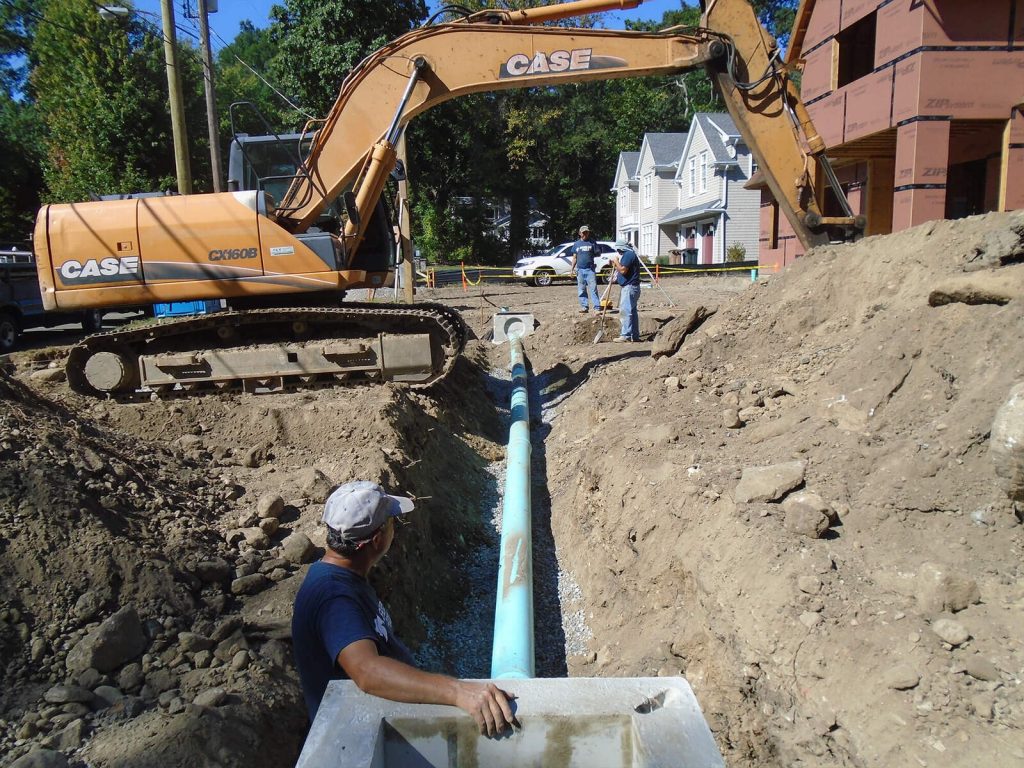Luxury pool construction certainly gives that butterflies in the stomach feeling. But, the logistical challenges that come with it can kill those butterflies. For example, many Rockland county homeowners wonder “How Do You Get Heavy Equipment Into a Backyard in Rockland?” There’s tight driveways, steep slopes, and mature trees everywhere.
Yet, experienced contractors solve the puzzle of moving heavy cranes, excavators, and materials into these spaces. Their solution takes planning, permits, and professional crane staging Rockland practices that meet local and state regulations.
For homeowners exploring backyard crane access Rockland County, this process may sound intimidating. But, it’s entirely manageable with the right team. Licensed builders and local permitting offices work together to ensure equipment reaches the site safely and legally, from setup through inspection. For an inside look at how pros handle complex terrain, check out How Do You Build a Luxury Pool on Westchester Rock?
Quick Answer
Homeowners can get heavy equipment into a Rockland backyard by following five essential steps:
(1) get the right pool construction permits in Clarkstown and county road approvals,
(2) coordinate with your HOA early to meet HOA construction rules in NY,
(3) plan safe crane and excavator access using mats, smaller equipment, or overhead lifts,
(4) communicate with neighbors and schedule work during approved hours, and
(5) restore and inspect the property after construction.
These steps ensure the project stays compliant, safe, and efficient while preventing unnecessary yard damage.
Why Rockland Homeowners Need Careful Access Planning
Rockland’s steep terrain and tight residential layouts demand careful access planning. Every move must follow both county permits and HOA construction rules NY puts in place to maintain community aesthetics and safety. Proper staging also prevents property damage and ensures compliance with local and state building codes.
Permits and inspections protect homeowners from liability and damage risks. Before work begins, building officials review staging maps, traffic plans, and erosion controls. These approvals confirm the site can safely handle large machinery without impacting neighboring structures or public utilities.
If you’re still weighing whether to start your pool journey, Top Pool Building Questions can help you plan smarter from the start.
Step 1: Get the Right Permits Before Any Work Begins
What permits do Rockland homeowners need for pool construction?
Permits plant the seeds of every new luxury pool construction project. You’ll need Rockland County road permits if staging equipment on or near public roads. They’re a huge part of crane staging in Rockland. The Town of Clarkston also requires permits for any structural change, excavation, or pool over 24 inches deep.
Permits you’ll need (and in what order):
- Building Permit: Covers excavation, crane use, and pool installation.
- Road Permit: Allows staging and equipment movement over county property.
- Tree Preservation Plan: Required for access through landscaped areas.
- Electrical/Plumbing Inspections: Conducted by licensed third-party agencies.
Each permit application includes a staging plan, traffic-control details, and proof of insurance. County inspectors confirm that road plates, mats, and crane outriggers follow NYSDOT standards. This process ensures crane staging in Rockland neighborhoods meets all safety and legal benchmarks. Many homeowners search early for pool construction permits Clarkstown requires to avoid spring scheduling delays.
If your goal is to enjoy your new pool by the start of summer, it helps to plan early. See When Should I Start to Swim by Memorial Day in NY? for a timeline that aligns with local construction schedules.
Step 2: Work With Your HOA Early to Avoid Delays
How do HOA construction rules in NY affect pool projects?
Most Rockland subdivisions operate under HOA construction rules in NY. Most homeowners’ associations dictate how and when construction can occur. They set rules about heavy machinery crossing shared driveways, sidewalks, or landscaped buffers.
How to stay compliant with your HOA:
- Submit access diagrams showing crane or excavator paths.
- Provide a communication plan for neighbors and residents.
- Get written HOA approval before applying for county permits.
- Follow restoration and cleanup standards set by your HOA agreement.
By aligning with HOA construction rules in NY, contractors prove they respect community and state-level cooperative policies. This transparency helps projects move faster through municipal review and avoids disputes with neighbors. If you’re planning your first backyard project, Essential Tips for First-Time Pool Owners offers helpful insights to set expectations before construction begins.
Step 3: Proven Equipment Access & Crane Staging Solutions for Rockland Yards
How do contractors safely get heavy equipment into Rockland backyards?
With permits and HOA approvals secured, it’s time to work out the physical logistics. Safe crane staging Rockland practices protect property and people. Specialized machinery and materials minimize impact.
Crane Staging That Keeps Rockland Backyards Safe
How professionals handle backyard crane access Rockland County:
- Use mobile cranes with 50–100 ft booms to lift materials over homes or fences.
- Place outriggers on steel or composite mats that distribute up to 50 tons of weight.
- Follow NYSDOT Work Zone Traffic Control standards when near streets or sidewalks.
- Conduct test lifts and boom-radius checks before starting excavation.
In dense neighborhoods, they may close sections of streets—with county approval—to allow full, safe reach for cranes.
Compact Excavators and Loaders for Tight Residential Access
Smaller excavators and skid steers—often under 10 tons—fit through gates as narrow as 6 feet. That makes them great for Rockland’s dense neighborhoods and HOA communities. Track-mounted models provide traction on sloped terrain and reduce soil compaction around landscaped areas.
Contractors plan safe excavator entry for sloped yards NY by looking at soil type, gradient, and turning radius. They prefer rubber-tracked models for delicate surfaces, while dual-access routes reduce ruts or drainage disruption.
Protective Mats, Plates, and Surface Safeguards Homeowners Appreciate
Both Rockland and Westchester Counties need protective surface measures during construction. Contractors deploy temporary mats or road plates on lawns and driveways to prevent rutting, especially when crane staging in Rockland. Clarkstown’s Building Department also mandates pre- and post-project documentation.
Typical surface protection steps:
- Lay interlocking modular mats along equipment paths.
- Use steel plates to spread heavy loads on asphalt or concrete.
- Clean and reuse mats to meet sustainability goals.
Tree and Fence Protection During Pool Construction
Tree and fence protection checklist:
- Fence root zones per Clarkstown’s Tree Ordinance.
- Mulch and aerate soil around trunks.
- Restore or replace fences affected by access routes.
- Schedule pruning under arborist supervision for overhanging trees.
If your yard design includes new greenery or privacy features, see Poolside Landscaping Benefits for inspiration on balancing form and function after the build.
Table: Equipment and Protection Methods Every Homeowner Should Know
| # | Equipment/Method | Use Case | Permit or Code Reference | Example Application |
| 1 | 50-ton mobile crane | Overhead lift for tight sites | Rockland Building Code; Westchester DPW | Position crane on mats in driveway |
| 2 | Mini excavator (<10 tons) | Narrow yard entry | Clarkstown Building Permit | Navigate 6–8 ft gates |
| 3 | Composite mats | Driveway protection | Road Permit Standards | Distribute weight evenly |
| 4 | Tree fencing | Root preservation | Clarkstown Tree Ordinance | Fence root zones along path |
| 5 | Silt fencing | Erosion control | NYS Environmental Code | Prevent slope washouts |
Step 4: Keep Neighbors Happy and Follow Local Work Hour Rules
Rockland projects depend on community cooperation. Local codes and HOA construction rules NY require contractors to keep residents informed and work within approved hours. When crane staging takes place near a public right-of-way, road permits also demand visible safety measures and flaggers.
Basic neighbor-communication steps:
- Deliver notices at least a week before staging.
- Outline daily work hours and provide a contact number.
- Mark crane positions and maintain safety signage.
- Control dust, debris, and cleanup promptly.
- Coordinate emergency or shared-driveway access if needed.
Crews also use cones, signage, and traffic control per NYSDOT requirements, maintaining clear lanes for emergency vehicles. Contractors who manage crane staging Rockland projects respectfully tend to earn smoother inspections and long-term goodwill in HOA communities.
Step 5: How to Restore Your Yard and Pass Final Inspections
What should Rockland homeowners expect during final inspections?
Restoration is the last impression you leave on the neighborhood—and inspectors notice. Both town and county codes need full site restoration and cleanup before considering a permit complete. Treat this as a final phase of construction, not an afterthought.
Checklist for Rockland Homeowners: Final Cleanup and Restoration
Final cleanup sequence:
- Remove mats, plates, and barriers once ground stabilizes.
- Regrade and reseed disturbed lawns; apply mulch to slopes.
- Patch or re-sand pavers and repair any cracked concrete.
- Reinstall fences or gates removed for access.
- Replace trees per Clarkstown’s preservation ratio.
- Clean driveways, sweep streets, and document with photos.
Inspection and Documentation to Close Out Your Permit
Permit closeout steps:
- Schedule a final inspection with the Town of Clarkstown or Rockland County.
- Provide photo evidence of site restoration.
- Submit required affidavits for road or staging permits.
- Receive final approval or certificate of occupancy after verification.
| # | Task | Responsible Party | Verification |
| 1 | Mat removal & cleanup | General Contractor | Photos |
| 2 | Lawn restoration | GC / Landscaper | Seed tags + pictures |
| 3 | Driveway repair | GC / Hardscape Sub | Invoice + photos |
| 4 | Fence reinstall | GC / Fence Sub | Alignment check |
| 5 | Final inspection | GC + Homeowner | Signed inspection card |
Create a “restoration binder” that includes inspection cards, warranties, and before-and-after images. This documentation proves the project followed crane staging Rockland and HOA restoration rules. It’ll be quite valuable to future buyers and home appraisers.
Key Takeaways for Rockland Homeowners
- Permits first: Building and road permits are mandatory before any crane staging Rockland project begins.
- Follow HOA construction rules NY: Secure approvals early and respect shared property standards.
- Plan the path: Submit a detailed staging map with crane pads, mats, and NYSDOT-compliant traffic control.
- Protect property: Use mats, compact machinery, and fencing to avoid damage during heavy equipment access.
- Communicate early: Notify neighbors, maintain signage, and avoid peak traffic hours.
- Document thoroughly: Photos, receipts, and inspection reports speed final approvals.
- Restore completely: Regrade lawns, reseal hardscapes, and repair surfaces for sign-off.
- Work professionally: Align with local codes and HOA rules to keep projects neighbor-friendly and on schedule.
- For any backyard crane access Rockland County project, partner with contractors experienced in local regulations to cut risk and ensure compliance from day one.
Professional Planning Makes Pool Construction Easy
Getting heavy equipment into a Rockland backyard can sound daunting, but expert contractors make it routine. By following crane staging Rockland safety standards and HOA construction rules NY, the process becomes efficient, predictable, and fully compliant.
Rockland’s layered framework—permits, codes, and HOA oversight—exists to protect homeowners and preserve neighborhoods. When you hire professionals who understand every regulation, you gain peace of mind knowing your investment meets every requirement.
In short, careful coordination, compliance, and communication turn a challenging project into a seamless success—from staging the first crane pad to restoring the last blade of grass.
Resources
Clarkstown.gov – Building Permits
New York State Department of Law – Simplified Procedure for Homeowners Associations with a De Minimis Cooperative Interest
RocklandCounty.gov – Buildings & Codes
Westchester.gov – Building Approvals and Road Permits




